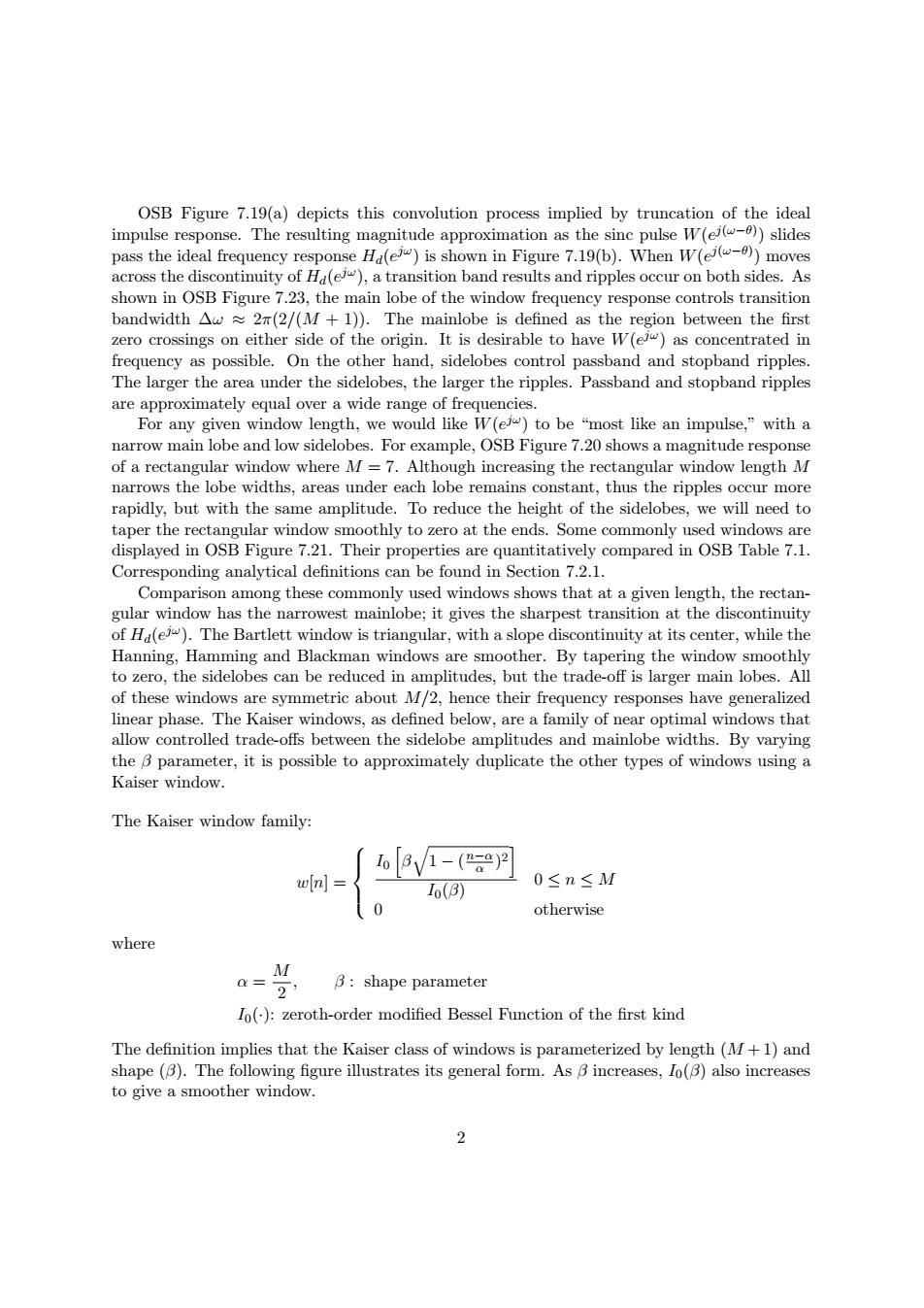正在加载图片...

OSB Figure 7.19(a)depicts this convolution process implied by truncation of the ideal impulse response.The resulting magnitude approximation as the sinc pulse W(ei(-0))slides pass the ideal frequency response Ha(e)is shown in Figure 7.19(b).When W(ei(-))moves across the discontinuity of Ha(e),a transition band results and ripples occur on both sides.As shown in OSB Figure 7.23,the main lobe of the window frequency response controls transition bandwidth Aw2(2/(M+1)).The mainlobe is defined as the region between the first zero crossings on either side of the origin.It is desirable to have W(ej)as concentrated in frequency as possible.On the other hand,sidelobes control passband and stopband ripples. The larger the area under the sidelobes,the larger the ripples.Passband and stopband ripples are approximately equal over a wide range of frequencies. For any given window length,we would like W(ei)to be "most like an impulse,"with a narrow main lobe and low sidelobes.For example,OSB Figure 7.20 shows a magnitude response of a rectangular window where M=7.Although increasing the rectangular window length M narrows the lobe widths,areas under each lobe remains constant,thus the ripples occur more rapidly,but with the same amplitude.To reduce the height of the sidelobes,we will need to taper the rectangular window smoothly to zero at the ends.Some commonly used windows are displayed in OSB Figure 7.21.Their properties are quantitatively compared in OSB Table 7.1. Corresponding analytical definitions can be found in Section 7.2.1. Comparison among these commonly used windows shows that at a given length,the rectan- gular window has the narrowest mainlobe;it gives the sharpest transition at the discontinuity of Ha(e).The Bartlett window is triangular,with a slope discontinuity at its center,while the Hanning,Hamming and Blackman windows are smoother.By tapering the window smoothly to zero,the sidelobes can be reduced in amplitudes,but the trade-off is larger main lobes.All of these windows are symmetric about M/2,hence their frequency responses have generalized linear phase.The Kaiser windows,as defined below,are a family of near optimal windows that allow controlled trade-offs between the sidelobe amplitudes and mainlobe widths.By varying the B parameter,it is possible to approximately duplicate the other types of windows using a Kaiser window. The Kaiser window family: 1- (。)2 Io(B) 0≤n≤M otherwise where M Q= 2’ 3:shape parameter Io():zeroth-order modified Bessel Function of the first kind The definition implies that the Kaiser class of windows is parameterized by length(M+1)and shape (B).The following figure illustrates its general form.As B increases,Io(B)also increases to give a smoother window. 2OSB Figure 7.19(a) depicts this convolution process implied by truncation of the ideal impulse response. The resulting magnitude approximation as the sinc pulse W(ej(ω−θ) ) slides pass the ideal frequency response Hd(ejω) is shown in Figure 7.19(b). When W(ej(ω−θ) ) moves across the discontinuity of Hd(ejω), a transition band results and ripples occur on both sides. As shown in OSB Figure 7.23, the main lobe of the window frequency response controls transition bandwidth Δω ≈ 2π(2/(M + 1)). The mainlobe is defined as the region between the first zero crossings on either side of the origin. It is desirable to have W(ejω) as concentrated in frequency as possible. On the other hand, sidelobes control passband and stopband ripples. The larger the area under the sidelobes, the larger the ripples. Passband and stopband ripples are approximately equal over a wide range of frequencies. For any given window length, we would like W(ejω) to be “most like an impulse,” with a narrow main lobe and low sidelobes. For example, OSB Figure 7.20 shows a magnitude response of a rectangular window where M = 7. Although increasing the rectangular window length M narrows the lobe widths, areas under each lobe remains constant, thus the ripples occur more rapidly, but with the same amplitude. To reduce the height of the sidelobes, we will need to taper the rectangular window smoothly to zero at the ends. Some commonly used windows are displayed in OSB Figure 7.21. Their properties are quantitatively compared in OSB Table 7.1. Corresponding analytical definitions can be found in Section 7.2.1. Comparison among these commonly used windows shows that at a given length, the rectangular window has the narrowest mainlobe; it gives the sharpest transition at the discontinuity of Hd(ejω). The Bartlett window is triangular, with a slope discontinuity at its center, while the Hanning, Hamming and Blackman windows are smoother. By tapering the window smoothly to zero, the sidelobes can be reduced in amplitudes, but the trade-off is larger main lobes. All of these windows are symmetric about M/2, hence their frequency responses have generalized linear phase. The Kaiser windows, as defined below, are a family of near optimal windows that allow controlled trade-offs between the sidelobe amplitudes and mainlobe widths. By varying the β parameter, it is possible to approximately duplicate the other types of windows using a Kaiser window. The Kaiser window family: w[n] = ⎧ ⎪ ⎩ ⎨ ⎪ I0 � β � 1 − (n−α)2 � α I0(β) 0 ≤ n ≤ M 0 otherwise where M α = 2 , β : shape parameter I0(·): zeroth-order modified Bessel Function of the first kind The definition implies that the Kaiser class of windows is parameterized by length (M +1) and shape (β). The following figure illustrates its general form. As β increases, I0(β) also increases to give a smoother window. 2